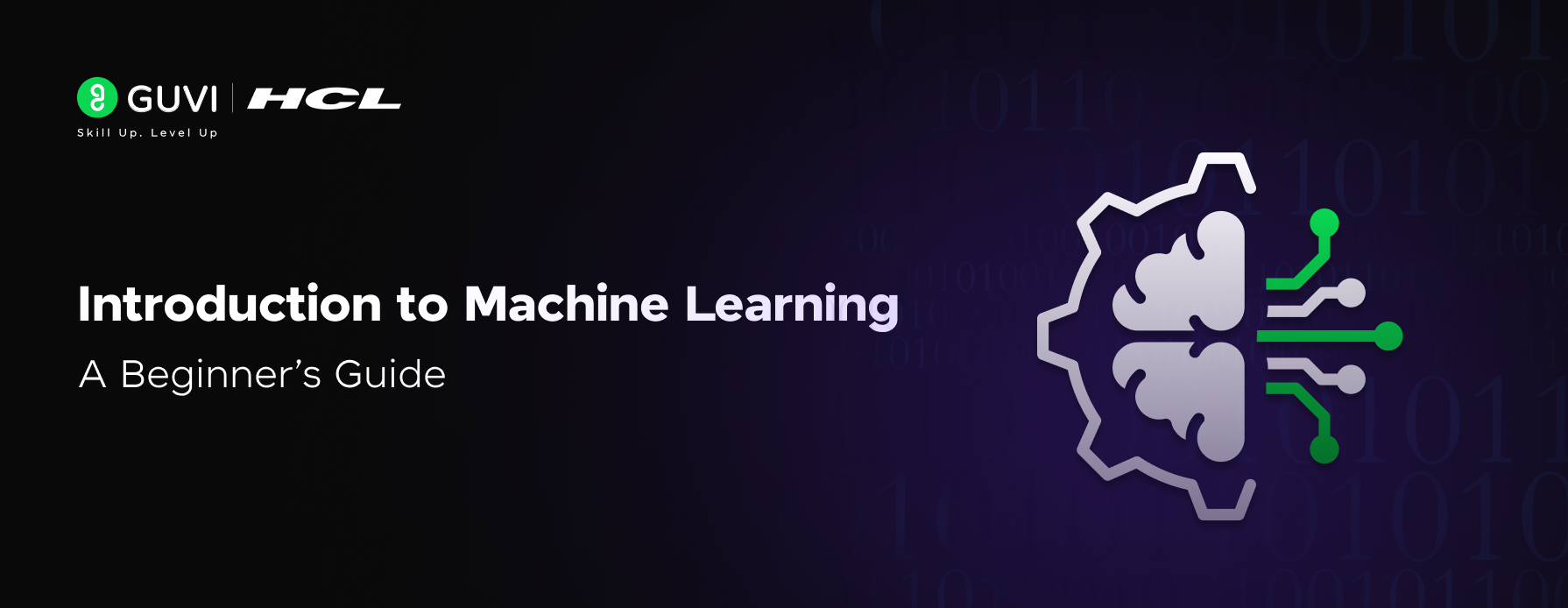
Introduction To Machine Learning: A Comprehensive Guide
Jan 08, 2025 5 Min Read 3643 Views
(Last Updated)
In a world increasingly driven by data, Machine Learning (ML) stands out as one of the most transformative technologies of the modern age.
ML is shaping the future in ways we couldn’t have imagined a decade ago, from powering personalized recommendations on your favorite streaming platforms to enabling groundbreaking medical discoveries.
But what exactly is machine learning, and how does it work? In this article, we’ll break down the basics, explain key concepts, and explore why ML is more relevant than ever. So, without further ado, let us get started!
Table of contents
- What is Machine Learning?
- Why is Machine Learning Important?
- Types of Machine Learning
- Supervised Learning
- Unsupervised Learning
- Reinforcement Learning
- How Does Machine Learning Work?
- Tools and Languages for Machine Learning
- Programming Languages
- Libraries and Frameworks
- Platforms and Tools
- Salary Range of Machine Learning Engineer
- Getting Started with Machine Learning
- Conclusion
- FAQs
- What is machine learning?
- What are the main types of machine learning?
- How does supervised learning differ from unsupervised learning?
- What programming languages are commonly used in machine learning?
- What is the typical workflow of a machine learning project?
What is Machine Learning?
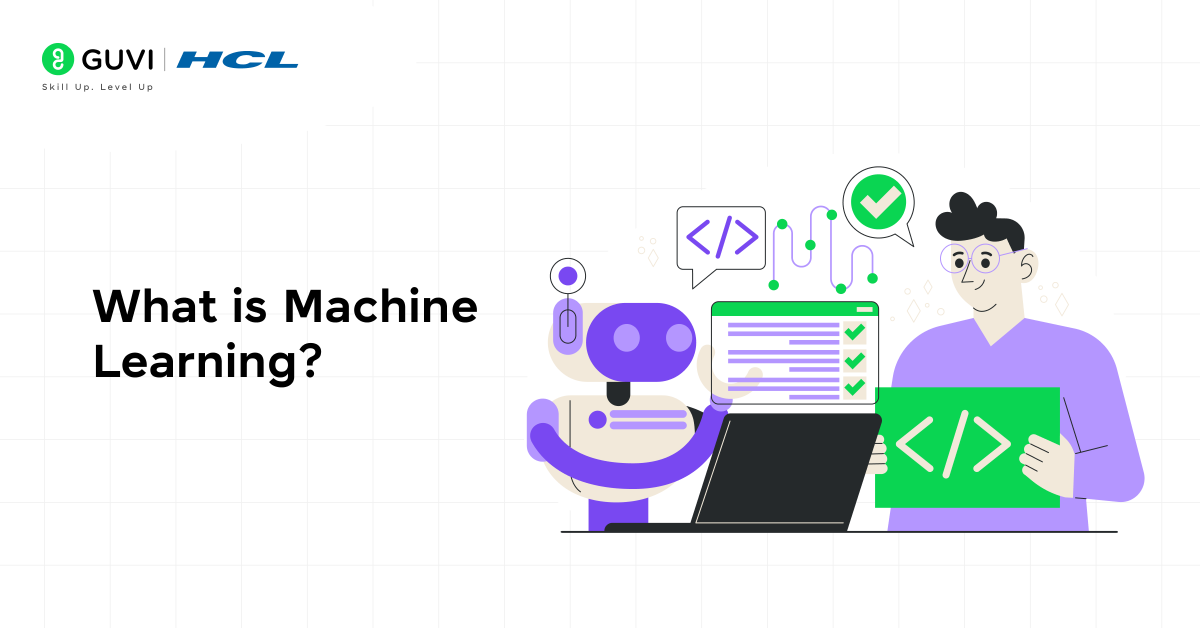
In simple terms, Machine Learning is a branch of artificial intelligence (AI) that enables computers to learn from data and make decisions or predictions without being explicitly programmed for every scenario.
Instead of writing detailed instructions for every possible case, we train a model by feeding it data and letting it figure out patterns or insights on its own.
Think of it like teaching a child to recognize fruits. Instead of listing every characteristic of an apple or a banana, you show the child several examples of each, and over time, they start identifying them correctly. That’s essentially what ML does – learning from examples.
Why is Machine Learning Important?
Machine Learning is revolutionizing industries, from healthcare to finance to entertainment. Here’s why it’s such a big deal:
- Automation: It helps automate tasks that are too complex for traditional programming, like image recognition or voice commands.
- Improved Accuracy: ML models can process vast amounts of data, often finding patterns humans might miss, leading to better decisions.
- Personalization: From Netflix recommendations to personalized ads, ML makes experiences more tailored to individual users.
Types of Machine Learning
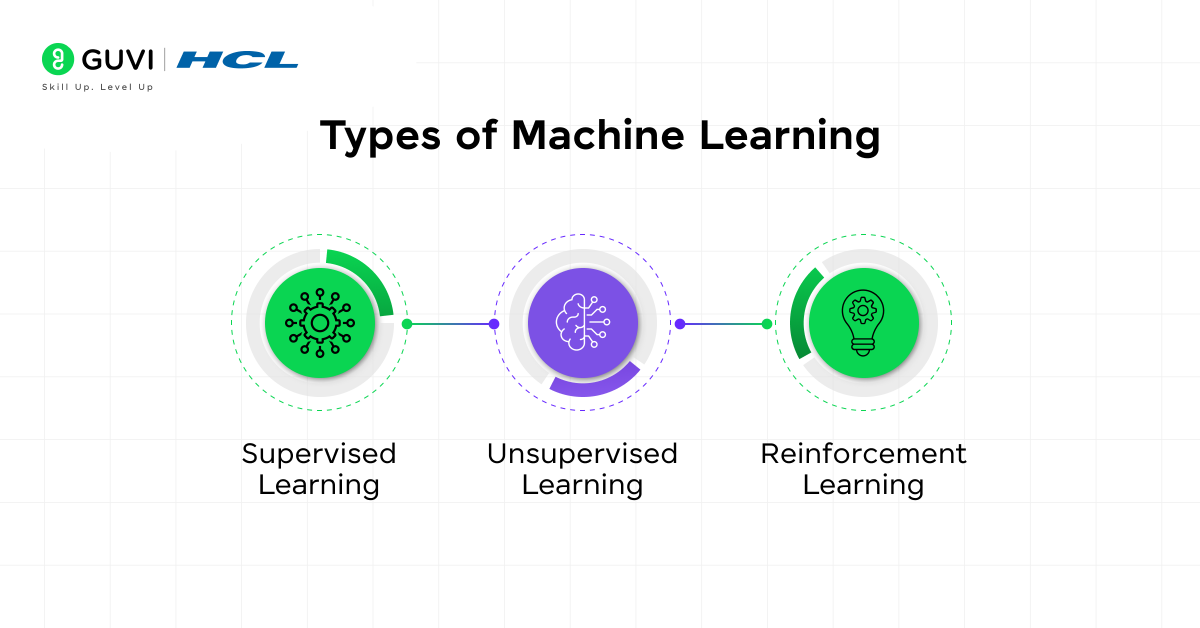
Machine learning (ML) can be broadly categorized into three main types: Supervised Learning, Unsupervised Learning, and Reinforcement Learning. Each type serves different purposes and works in distinct ways.
1. Supervised Learning
Supervised learning is like having a teacher guide the learning process. You provide the algorithm with input data (features) and the corresponding correct outputs (labels), and it learns to map inputs to outputs.
- How It Works:
- You give the model a dataset with labeled examples. For instance, if you’re training a model to recognize fruits, the input might be images of fruits, and the labels would specify whether each image is an “apple,” “banana,” etc.
- The model learns from this training data by minimizing errors using techniques like gradient descent.
- Once trained, the model can predict the output for new, unseen data.
- Key Algorithms:
- Linear Regression
- Logistic Regression
- Decision Trees
- Support Vector Machines (SVM)
- Neural Networks
2. Unsupervised Learning
Unsupervised learning is a bit like exploring a new city without a map. The algorithm is given input data but no labels – it has to find patterns, groupings, or structures in the data on its own.
- How It Works:
- The model analyzes the data to find hidden patterns or relationships.
- It groups or clusters similar data points together or reduces data dimensions for easier analysis.
- Key Algorithms:
- Clustering Algorithms: K-Means, DBSCAN, Hierarchical Clustering.
- Dimensionality Reduction: Principal Component Analysis (PCA), t-SNE.
3. Reinforcement Learning
Reinforcement learning (RL) is like teaching a dog new tricks by rewarding good behavior. The algorithm learns by interacting with an environment, making decisions, and receiving feedback in the form of rewards or penalties.
- How It Works:
- An agent (the learner) interacts with an environment (the system or world in which it operates).
- The agent takes actions based on a policy (a strategy for making decisions).
- It receives feedback (rewards or penalties) based on the outcome of its actions.
- Over time, the agent learns to maximize cumulative rewards.
- Key Concepts:
- Policy: The strategy for choosing actions.
- Reward Signal: Feedback that the agent uses to improve.
- Value Function: Predicts long-term rewards for a state or action.
- Exploration vs. Exploitation: Balancing trying new actions (exploration) and using known rewarding actions (exploitation).
How Does Machine Learning Work?
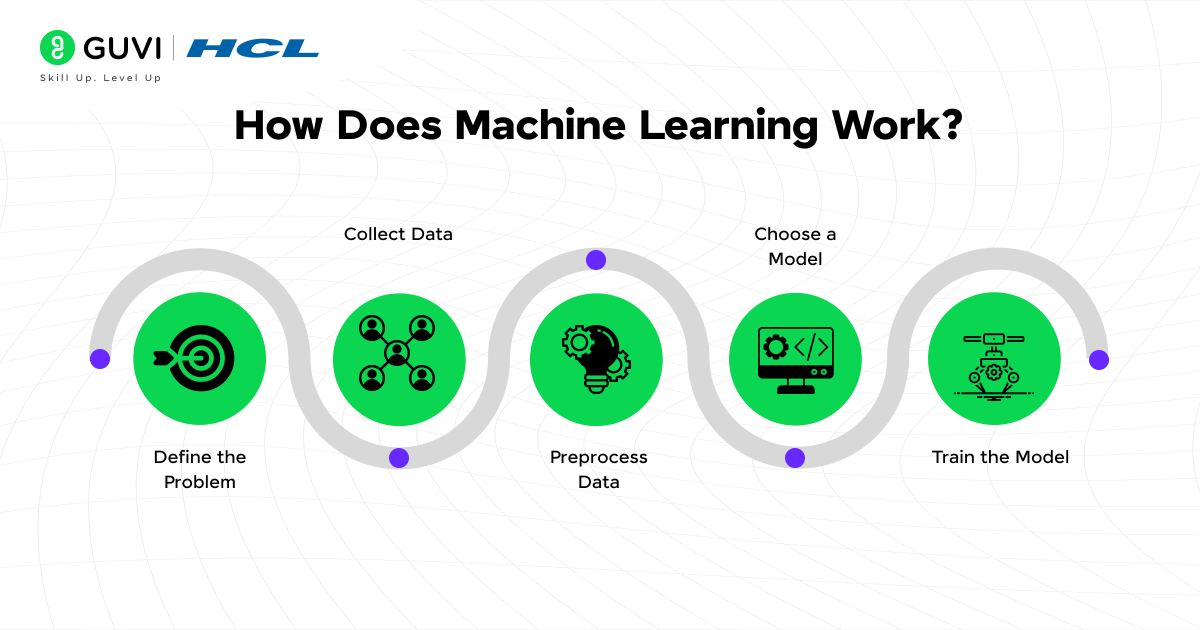
The process of machine learning can be broken down into several stages. Whether you’re building a simple regression model or a complex neural network, these steps are fundamental.
- Define the Problem: Before diving into the data or algorithms, it’s crucial to understand what you want to achieve.
- Collect Data: High-quality data is the foundation of a good ML model. The more relevant and comprehensive your data, the better your model will perform.
- Preprocess Data: Raw data is rarely ready for ML. Preprocessing includes:
- Cleaning: Handling missing values, removing duplicates, and correcting errors.
- Normalization/Standardization: Scaling data to ensure consistency.
- Encoding: Converting categorical data into numerical formats.
- Splitting: Dividing data into training, validation, and test sets.
- Choose a Model: Select an algorithm suited to your problem type:
- Regression for continuous outputs (e.g., predicting prices).
- Classification for discrete categories (e.g., spam vs. not spam).
- Clustering for grouping data without labels.
- Train the Model: The model learns by identifying patterns in the training data. During training:
- Data is fed into the algorithm in batches.
- The model updates its parameters (e.g., weights in a neural network) to minimize errors.
Machine learning is an iterative process, and each step contributes to building smarter and more reliable systems.
Tools and Languages for Machine Learning
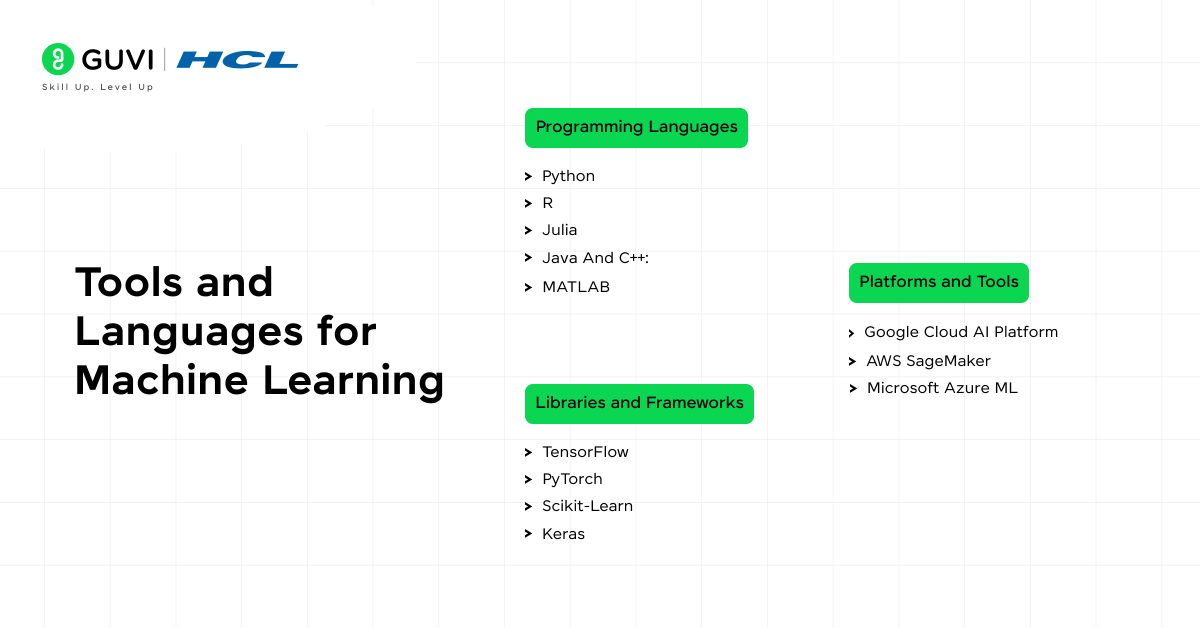
The field of machine learning (ML) is powered by a rich ecosystem of tools and programming languages that make it easier to build, train, and deploy models. Let’s explore these in detail.
1. Programming Languages
The backbone of any ML project is the programming language used to write code and implement models. Here are the most commonly used languages:
- Python:
Python is the most popular language for ML, thanks to its simplicity, readability, and extensive library ecosystem. Libraries like TensorFlow, PyTorch, Scikit-learn, and NumPy make Python a powerful choice for ML projects. - R:
R is particularly strong in statistical modeling and data visualization. It’s widely used by data scientists for exploratory data analysis and machine learning. - Julia:
Julia is gaining traction for ML due to its high performance, making it suitable for handling large datasets and complex computations. - Java and C++:
These are used for ML applications where performance is critical, such as large-scale systems or embedded devices. Libraries like Weka (Java) and Shark (C++) are helpful in this domain. - MATLAB:
Popular in academic and research settings, MATLAB offers excellent tools for mathematical modeling and prototyping ML algorithms.
2. Libraries and Frameworks
Libraries and frameworks simplify the development process by providing pre-built functions and modules for various ML tasks.
- TensorFlow:
Developed by Google, TensorFlow is one of the most widely used frameworks for deep learning and ML. It supports multiple languages, though Python is the most common. - PyTorch:
Created by Facebook, PyTorch is loved for its dynamic computation graph, making it ideal for research and experimentation. It’s particularly strong in deep learning. - Scikit-learn:
A Python library focused on traditional ML algorithms like regression, classification, and clustering. It’s great for beginners and small projects. - Keras:
A high-level API for building neural networks, Keras runs on top of frameworks like TensorFlow and makes deep learning accessible.
3. Platforms and Tools
For scaling ML projects and working with large datasets, cloud platforms and integrated machine learning tools are essential.
- Google Cloud AI Platform:
Offers tools like BigQuery, AutoML, and pre-trained models to build and deploy ML solutions. - AWS SageMaker:
Amazon’s platform for building, training, and deploying models at scale, with support for multiple frameworks. - Microsoft Azure ML:
Provides end-to-end ML lifecycle management, including data preparation, model training, and deployment.
By understanding the tools and languages available and following a structured ML workflow, you can approach machine learning projects with confidence.
Salary Range of Machine Learning Engineer
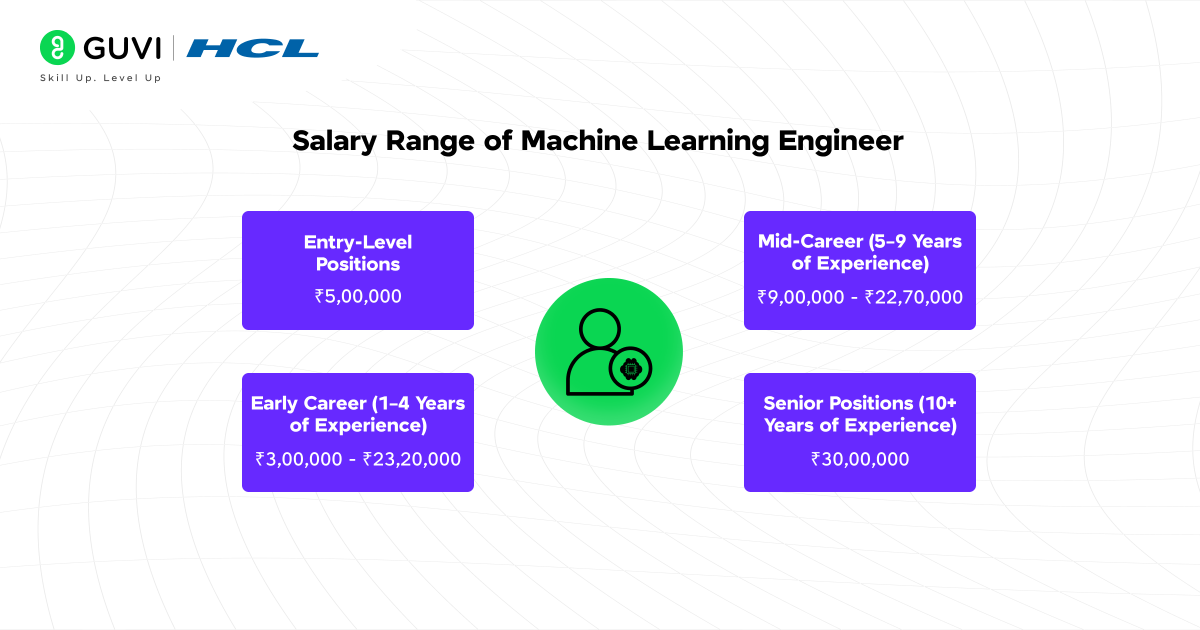
The salary of a Machine Learning Engineer in India varies based on factors such as experience, location, and the employing organization. Here’s a concise overview:
- Entry-Level Positions: Individuals with less than a year of experience can expect an average annual salary of approximately ₹5,00,000. (Careers360)
- Early Career (1–4 Years of Experience): Salaries typically range from ₹3,00,000 to ₹23,20,000 per year, with an average around ₹7,00,000. (AmbitionBox)
- Mid-Career (5–9 Years of Experience): Professionals in this bracket earn between ₹9,00,000 and ₹22,70,000 annually. (AmbitionBox)
- Senior Positions (10+ Years of Experience): Salaries can reach up to ₹30,00,000 or more per year, depending on the role and company. (Salary Expert)
These figures are approximate and can vary based on the specific employer, industry, and geographic location within India.
Getting Started with Machine Learning
Here are a few tips to begin your ML journey:
- Learn Python: Start with the basics and get comfortable with libraries like NumPy and pandas.
- Understand the Math: Brush up on statistics, linear algebra, and calculus. ML heavily relies on these areas.
- Explore Online Courses: Platforms like Coursera, edX, and YouTube offer beginner-friendly ML courses.
- Practice with Projects: Hands-on experience is crucial. Try building simple models like a movie recommender or digit classifier.
- Join Communities: Participate in forums like Kaggle, GitHub, or Reddit to learn from others and share knowledge.
In case you want to explore more about Artificial Intelligence and Machine Learning, consider enrolling for GUVI’s Artificial Intelligence and Machine Learning course that teaches you everything related to it with an industry-grade certificate.
Conclusion
In conclusion, Machine Learning might seem intimidating at first, but it’s like learning any new skill—start small, keep practicing, and you’ll get the hang of it.
The potential of ML is immense, and by diving in now, you’re stepping into one of the most exciting fields of the 21st century.
So, what are you waiting for? Fire up your laptop, open up Python, and start exploring the endless possibilities of Machine Learning!
FAQs
Machine learning is a subset of artificial intelligence that enables computers to learn from data and make decisions or predictions without explicit programming.
The primary types are supervised learning (learning from labeled data), unsupervised learning (identifying patterns in unlabeled data), and reinforcement learning (learning through rewards and penalties).
In supervised learning, models are trained on labeled data with known outputs, while in unsupervised learning, models work with unlabeled data to uncover hidden patterns or intrinsic structures.
Python is the most popular language due to its extensive libraries like TensorFlow and Scikit-learn. R is also widely used, especially for statistical analysis and data visualization.
A typical ML workflow includes defining the problem, collecting and preprocessing data, selecting a model, training the model, evaluating its performance, and deploying it for real-world use





















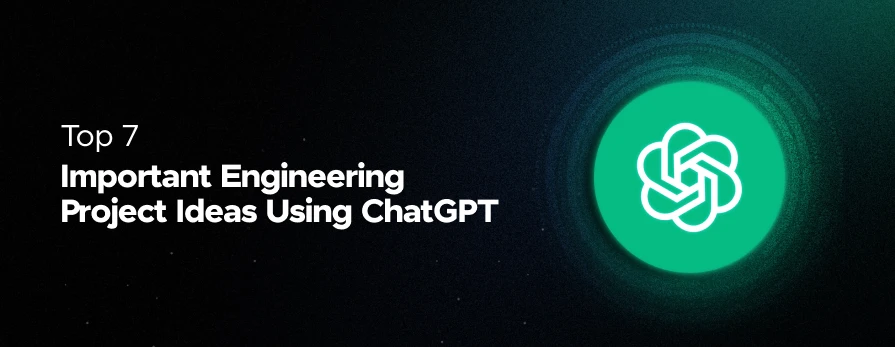

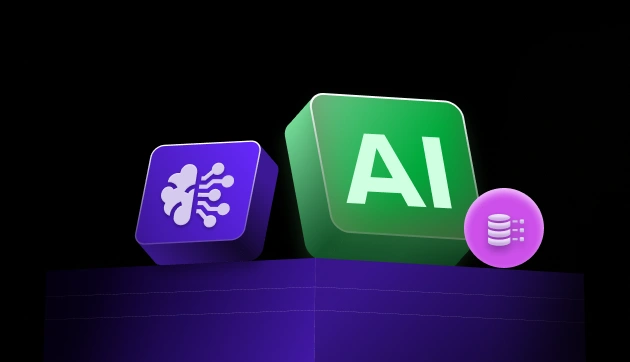

Did you enjoy this article?